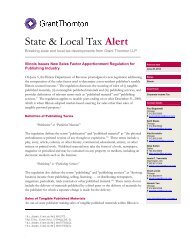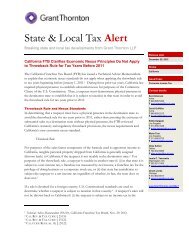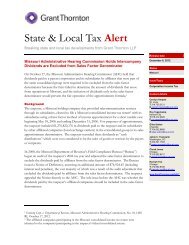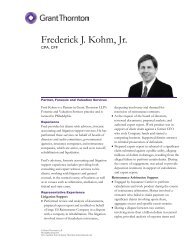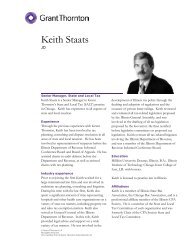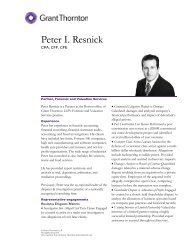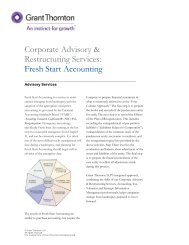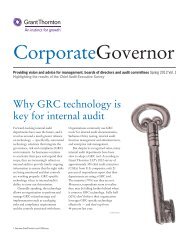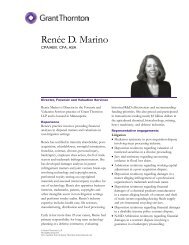On your mark, get set, go for the exit - Grant Thornton LLP
On your mark, get set, go for the exit - Grant Thornton LLP
On your mark, get set, go for the exit - Grant Thornton LLP
You also want an ePaper? Increase the reach of your titles
YUMPU automatically turns print PDFs into web optimized ePapers that Google loves.
DECEMBER 2012<br />
<strong>On</strong> <strong>your</strong> <strong>mark</strong>, <strong>get</strong> <strong>set</strong>, <strong>go</strong> <strong>for</strong> <strong>the</strong> <strong>exit</strong>
Contents<br />
2 Overview: The outlook is rosy<br />
6 Exits by type: Corporate acquisitions,<br />
secondary buyouts and IPOs<br />
9 The big tax change<br />
10 Industry focus<br />
Health care<br />
IT<br />
Financial services<br />
Energy<br />
B2B<br />
B2C<br />
Materials and resources<br />
24 Exits by state and region<br />
25 About <strong>the</strong> contributors
Fall 2012<br />
Dear Reader:<br />
Despite a slow year <strong>for</strong> private equity deal flow, <strong>the</strong> <strong>exit</strong> <strong>mark</strong>et continues to heat up as firms redouble <strong>the</strong>ir ef<strong>for</strong>ts to <strong>exit</strong> portfolio<br />
companies and realize investments. After years of <strong>go</strong>bbling up companies, private equity firms need to start winding down those<br />
investments <strong>for</strong> a number of reasons. First, firms that want to raise new funds need to be able to show limited partners that <strong>the</strong>y have<br />
delivered on some successful <strong>exit</strong>s. Second, <strong>the</strong> ever-looming increase in capital gains tax rates is pushing private equity firms to <strong>exit</strong><br />
portfolio companies during 2012 ra<strong>the</strong>r than face <strong>the</strong> prospect of paying higher taxes during 2013. And finally, <strong>the</strong> <strong>mark</strong>et is filled<br />
with willing buyers that have lots of capital to spend. Private equity firms, as well as strategic acquirers, have been sitting on capital<br />
that needs to be deployed. These potential buyers are itching to find <strong>go</strong>od acquisition tar<strong>get</strong>s.<br />
All of <strong>the</strong>se factors have led private equity firms to <strong>the</strong> realization that now is <strong>the</strong> time to <strong>exit</strong>. The proof is in <strong>the</strong> numbers: U.S.-<br />
based private equity firms completed 233 <strong>exit</strong>s in H1 2012 and are on track to realize approximately $100 billion in capital by <strong>the</strong> end of<br />
2012. Of course, not every <strong>exit</strong> is one to write home about, but <strong>the</strong>re were notable liquidity events during H1 2012, such as 3G Capital’s<br />
$1.4 billion deal to <strong>exit</strong> 29% of its shares of Burger King Worldwide and <strong>the</strong> IPO of Caesars Entertainment Corporation.<br />
What’s more, <strong>exit</strong> activity is expected to increase throughout <strong>the</strong> remainder of 2012. In addition to <strong>the</strong> confluence of factors<br />
mentioned above that is making <strong>the</strong> <strong>exit</strong> environment hot, <strong>the</strong> fact of <strong>the</strong> matter is that, after so much buying during <strong>the</strong> boom years, <strong>the</strong><br />
inventory of private equity-backed companies at <strong>the</strong> midyear is at a record high of 6,278. Obviously, <strong>the</strong> Great Recession threw many<br />
companies off <strong>the</strong>ir trajectories, and private equity firms held back on selling <strong>the</strong>m until <strong>mark</strong>et conditions improved and companies<br />
rebounded. Not surprisingly, this has led to private equity firms holding <strong>the</strong>ir portfolio companies <strong>for</strong> longer than ever be<strong>for</strong>e. The<br />
median holding period <strong>for</strong> a portfolio company rose from 3.49 years in 2007 to 5.33 years in H1 2012 — an increase of 53%.<br />
The <strong>go</strong>od news is that <strong>exit</strong> opportunities are picking up and private equity firms are taking full advantage of <strong>the</strong>se opportunities.<br />
Private equity firms are <strong>exit</strong>ing portfolio companies at a much quicker pace than <strong>the</strong>y have in <strong>the</strong> recent past. Consider this: From<br />
2003 through 2008, private equity firms completed 4.1 times more deals than <strong>exit</strong>s. During H1 2012, <strong>the</strong> number of deals that private<br />
equity firms completed was sitting at just 1.8 times <strong>the</strong> number of <strong>exit</strong>s. However, while this is a <strong>mark</strong>ed improvement, it’s not<br />
enough. Getting <strong>the</strong> ratio of deals to <strong>exit</strong>s below 1-to-1 is <strong>the</strong> only way <strong>for</strong> private equity firms to rein in company inventory. Even<br />
taking into account <strong>the</strong> accelerated pace at which <strong>the</strong>y are <strong>exit</strong>ing companies, private equity firms will need about nine years to sell<br />
off all of <strong>the</strong>ir extra inventory.<br />
As I mentioned, strategics and private equity firms alike are eager buyers. While IPO activity was strong in <strong>the</strong> first half of <strong>the</strong> year,<br />
it slowed in Q2. The IPO pipeline does not appear to be as full <strong>for</strong> <strong>the</strong> second half, but we could see change as <strong>the</strong> year draws closer<br />
to <strong>the</strong> end. Not every IPO has been a grand slam, but <strong>the</strong>re were plenty of solid private equity-backed offerings during <strong>the</strong> first half of<br />
2012, such as <strong>the</strong> successful IPOs of transmission company Allison Transmission and organic food company Annie’s Homegrown.<br />
Given <strong>the</strong> signs of optimism from <strong>the</strong> private equity <strong>mark</strong>et, we thought it was important to give our readers insight into <strong>the</strong> <strong>exit</strong><br />
<strong>mark</strong>et and what’s on <strong>the</strong> horizon. With this in mind, <strong>Grant</strong> <strong>Thornton</strong> <strong>LLP</strong>, in partnership with data provider PitchBook Data, Inc.,<br />
has developed <strong>the</strong> latest edition of this in-depth report, which contains data, charts and analyses that highlight recent <strong>exit</strong> activity and<br />
provide insight into <strong>the</strong> systemic shifts in private equity investing.<br />
Enjoy,<br />
Kevin Hudson<br />
National Managing Director, Private Equity<br />
<strong>Grant</strong> <strong>Thornton</strong> <strong>LLP</strong><br />
<strong>On</strong> <strong>your</strong> <strong>mark</strong>, <strong>get</strong> <strong>set</strong>, <strong>go</strong> <strong>for</strong> <strong>the</strong> <strong>exit</strong> 1
Overview: The outlook is rosy<br />
Despite — or perhaps because of — <strong>the</strong> heavy private equity<br />
investing that took place during <strong>the</strong> boom years, industry<br />
professionals have been predicting heightened <strong>exit</strong> activity <strong>for</strong><br />
several quarters. It appears that <strong>the</strong> time has finally come; 2012<br />
is charting a course to be one of <strong>the</strong> most active years ever <strong>for</strong><br />
<strong>exit</strong>s. Private equity firms are on track to complete more than<br />
450 <strong>exit</strong>s totaling about $100 billion.<br />
There are several factors that bode well <strong>for</strong> increased <strong>exit</strong><br />
activity. The potential change in tax rates is one of <strong>the</strong>m. Under<br />
current tax law, when a private equity firm sells a business,<br />
<strong>the</strong> money from that sale is treated as an investment profit,<br />
which is taxed at 15%. Likewise, partners in private equity<br />
firms pay taxes of roughly 15% on profits because those profits<br />
are considered investment returns or capital gains ra<strong>the</strong>r than<br />
income. This money could start <strong>get</strong>ting taxed at almost 24% as<br />
early as 2013. (See “The big tax change,” page 9.)<br />
“Historically, <strong>the</strong> number of <strong>exit</strong>s in <strong>the</strong> second half of a<br />
given year has been higher than <strong>the</strong> number of <strong>exit</strong>s in <strong>the</strong> first<br />
half. In 2009, 2010 and 2011, <strong>exit</strong>s in <strong>the</strong> second half were at<br />
least 53% of total annual <strong>exit</strong>s. And in any case, we expect to<br />
see an uptick in <strong>the</strong> number of <strong>exit</strong>s in H2 2012 because of <strong>the</strong><br />
likely change in tax laws starting in 2013. That prospect alone<br />
motivated both sellers and buyers to close deals in H1 2012,”<br />
observes Carlos Ferreira, a partner in <strong>Grant</strong> <strong>Thornton</strong> <strong>LLP</strong>’s<br />
Transaction Advisory Services (TAS) group.<br />
Exhibit 1: Exits by quarter<br />
Capital <strong>exit</strong>ed ($billions)<br />
Number of <strong>exit</strong>s<br />
Capital <strong>exit</strong>ed ($billions)<br />
Number of <strong>exit</strong>s<br />
$45<br />
$40<br />
$35<br />
$30<br />
$25<br />
$20<br />
$15<br />
$10<br />
120 120 127 120<br />
93<br />
74<br />
104<br />
45<br />
29 46<br />
36<br />
67<br />
72<br />
94<br />
85<br />
160<br />
83<br />
115<br />
107<br />
122 123<br />
110<br />
180<br />
160<br />
140<br />
120<br />
100<br />
80<br />
60<br />
40<br />
$5<br />
$0<br />
$28 $28 $27 $24 $21 $10 $29 $5 $13 $3 $6 $17 $16 $25 $23 $38 $22 $35 $22 $28 $27 $23<br />
Q1 Q2 Q3 Q4 Q1 Q2 Q3 Q4 Q1 Q2 Q3 Q4 Q1 Q2 Q3 Q4 Q1 Q2 Q3 Q4 Q1 Q2<br />
2007 2008 2009 2010 2011 2012<br />
Source: PitchBook.<br />
20<br />
0<br />
2 <strong>On</strong> <strong>your</strong> <strong>mark</strong>, <strong>get</strong> <strong>set</strong>, <strong>go</strong> <strong>for</strong> <strong>the</strong> <strong>exit</strong>
In addition to anticipating tax changes, private equity firms<br />
need to start <strong>exit</strong>ing <strong>the</strong>ir more than 6,200 portfolio companies<br />
and showing limited partnerships (LPs) wins on <strong>the</strong> balance<br />
sheet if <strong>the</strong>y plan to raise new funds. And perhaps <strong>the</strong> most<br />
important consideration is that <strong>the</strong>re are willing buyers.<br />
As Exhibit 4 illustrates, <strong>the</strong> number of <strong>exit</strong>s is becoming<br />
more consistent with <strong>the</strong> number of deals private equity firms<br />
are making — and this is proof that <strong>the</strong> <strong>exit</strong> <strong>mark</strong>et is heating<br />
up. In H1 2012, <strong>the</strong> number of deals was just 1.8 times <strong>the</strong><br />
number of <strong>exit</strong>s, a <strong>mark</strong>ed improvement from where <strong>the</strong> deal<strong>exit</strong><br />
discrepancy was be<strong>for</strong>e. In 2010, <strong>for</strong> example, deal volume<br />
was nearly three times <strong>exit</strong> volume, and <strong>the</strong> results <strong>for</strong> 2011 were<br />
much <strong>the</strong> same, with deal activity outpacing <strong>exit</strong>s 2.7 to 1. Years<br />
of overzealous investing cannot be undone overnight. Even at<br />
today’s more balanced pace, it is <strong>go</strong>ing to take almost nine years<br />
just to sell <strong>the</strong> 4,000 companies that private equity firms acquired<br />
in 2008 or earlier.<br />
Exhibit 3: Median holding period by <strong>exit</strong> year<br />
Number of years held<br />
6<br />
5<br />
4<br />
3<br />
2<br />
1<br />
4.17<br />
0<br />
3.84 4.24 3.70 3.68 3.49 3.92 3.91 4.72 4.87 5.33<br />
2002 2003 2004 2005 2006 2007 2008 2009 2010 2011 2012*<br />
Year of <strong>exit</strong><br />
* As of June 30, 2012.<br />
Source: PitchBook.<br />
Exhibit 2: Exits by year<br />
Capital <strong>exit</strong>ed ($billions) Number of <strong>exit</strong>s<br />
Capital <strong>exit</strong>ed ($billions)<br />
Number of <strong>exit</strong>s<br />
$140<br />
$120<br />
$100<br />
$80<br />
$60<br />
$40<br />
$20<br />
$0<br />
440<br />
487<br />
411 427<br />
374<br />
316<br />
304<br />
233<br />
168<br />
$25 $54 $71 $119 $107 $64<br />
178<br />
$39 $103 $107 $49<br />
2003 2004 2005 2006 2007 2008 2009 2010 2011 2012<br />
Source: PitchBook.<br />
600<br />
500<br />
400<br />
300<br />
200<br />
100<br />
0<br />
Exhibit 4: U.S. private equity investments and <strong>exit</strong>s<br />
1,218 1,174<br />
Number of deals (excluding add-ons) Number of <strong>exit</strong>s<br />
2,000<br />
1,951<br />
1,708<br />
1,481<br />
1,500<br />
1,374<br />
1,209<br />
948<br />
890<br />
1,000<br />
500<br />
440 487<br />
304 374<br />
316 411 427<br />
168<br />
178<br />
416<br />
233<br />
0<br />
2003 2004 2005 2006 2007 2008 2009 2010 2011 2012*<br />
* As of June 30, 2012.<br />
Source: PitchBook.<br />
<strong>On</strong> <strong>your</strong> <strong>mark</strong>, <strong>get</strong> <strong>set</strong>, <strong>go</strong> <strong>for</strong> <strong>the</strong> <strong>exit</strong> 3
“In 2010 and 2011, private equity firms acquired<br />
approximately three companies <strong>for</strong> every company sold.<br />
In H1 2012, <strong>the</strong>y acquired approximately two companies <strong>for</strong><br />
every company sold,” says Ferreira. “The annual <strong>exit</strong> rate is<br />
clearly increasing.”<br />
Additionally, as a result of depressed <strong>mark</strong>et conditions,<br />
private equity firms held on to portfolio companies longer<br />
in hopes of selling <strong>the</strong>m at a higher value when <strong>the</strong> <strong>mark</strong>et<br />
recovered. The median holding period is now longer than five<br />
years — up an astounding 53% from <strong>the</strong> 3.49-year holding<br />
period recorded in 2007. Retail and automotive investments have<br />
<strong>the</strong> longest median holding period — more than 5.9 years —<br />
compared with <strong>the</strong> energy, and aerospace and defense industries,<br />
both of which have a median holding period of 4.3 years.<br />
Until <strong>the</strong> number of <strong>exit</strong>s begins to outpace <strong>the</strong> number<br />
of new investments, <strong>the</strong> median holding period <strong>for</strong> portfolio<br />
companies can only be expected to increase.<br />
“Overall, holding periods have grown significantly. Private<br />
equity firms have held <strong>the</strong>ir investments, hoping to sell when<br />
<strong>the</strong> recession ended. Although <strong>the</strong> economy hasn’t totally<br />
recovered, it’s a lot healthier than it was, and private equity firms<br />
are beginning to liquidate <strong>the</strong>ir holdings, allowing <strong>the</strong> number of<br />
<strong>exit</strong>s to begin to catch up with <strong>the</strong> number of new investments.<br />
Portfolio companies may not be selling at top dollar, but <strong>the</strong><br />
climate <strong>for</strong> <strong>exit</strong>s is much improved from <strong>the</strong> way it was a few<br />
years a<strong>go</strong>,” Ferreira says.<br />
Indeed, <strong>the</strong> reality is that <strong>mark</strong>et conditions haven’t<br />
improved as much as private equity firms had hoped, and <strong>the</strong>y<br />
have had to accept lower valuations on <strong>exit</strong>s. The median <strong>exit</strong><br />
size-to-EBITDA multiple peaked at 9x in 2007 and 2009 because<br />
private equity firms were willing to pay hefty premiums <strong>for</strong><br />
high-per<strong>for</strong>ming companies when deal opportunities dried<br />
up after <strong>the</strong> financial crisis. But with <strong>the</strong> median <strong>exit</strong> multiple<br />
currently at 7.4x, it is now a buyer’s <strong>mark</strong>et.<br />
Exhibit 5: Median <strong>exit</strong> values ($M) by <strong>exit</strong> type<br />
Corporate acquisition IPO Secondary buyout<br />
($millions)<br />
$350<br />
$300<br />
$250<br />
$200<br />
$150<br />
$176 $172<br />
$150<br />
$150 $168 $199<br />
$143<br />
$195<br />
$250<br />
$151<br />
$189 $190<br />
$157<br />
$261<br />
$220<br />
$161<br />
$301<br />
$211 $200<br />
$243<br />
$228<br />
$178<br />
$145<br />
$100<br />
$50<br />
$0<br />
2005 2006 2007 2008 2009<br />
2010 2011 2012*<br />
$78<br />
* As of June 30, 2012.<br />
Source: PitchBook.<br />
4 <strong>On</strong> <strong>your</strong> <strong>mark</strong>, <strong>get</strong> <strong>set</strong>, <strong>go</strong> <strong>for</strong> <strong>the</strong> <strong>exit</strong>
“The <strong>exit</strong> multiple may not be as high as sellers would like,<br />
but <strong>the</strong> alternative is holding portfolio companies and thus<br />
expanding <strong>the</strong> lives of <strong>the</strong>ir funds, which doesn’t sit well with<br />
LPs. LPs do not want to pay management fees on a portfolio of<br />
companies that were supposed to be <strong>exit</strong>ed years a<strong>go</strong>,” explains<br />
Sal Fira, a partner in <strong>Grant</strong> <strong>Thornton</strong> <strong>LLP</strong>’s TAS practice.<br />
According to some reports, <strong>the</strong> amounts tied up in <strong>the</strong>se<br />
so-called zombie funds are increasing. It is estimated that <strong>the</strong>y<br />
account <strong>for</strong> as much as $100 billion in as<strong>set</strong>s invested in more<br />
than 200 private equity funds. These unrealized funds drain<br />
as<strong>set</strong>s from LPs and leave <strong>the</strong>m with a bad taste when <strong>the</strong> time<br />
comes to reinvest.<br />
“Of course this is problematic <strong>for</strong> LPs. Not only are <strong>the</strong>y<br />
up<strong>set</strong> at having to pay more management fees than expected,<br />
but also <strong>the</strong> longer <strong>the</strong> investment is held, <strong>the</strong> higher <strong>the</strong> <strong>exit</strong><br />
value will need to be in order to match <strong>the</strong> fund’s tar<strong>get</strong> internal<br />
rate of return (IRR). It makes <strong>the</strong> value proposition all <strong>the</strong> more<br />
difficult to achieve,” says Fira.<br />
However, it is important to note that not all funds that have<br />
expanded <strong>the</strong>ir lives are in this position. Many funds have been<br />
able to realize a significant amount of <strong>the</strong>ir original investment<br />
through dividends and fees, thus making <strong>the</strong> prospect of a lower<br />
multiple less of a concern.<br />
Exhibit 6: Median <strong>exit</strong> EBITDA multiples<br />
9.5x<br />
9.0x<br />
9.0x<br />
9.0x<br />
8.5x<br />
8.0x<br />
7.5x<br />
7.0x<br />
6.5x<br />
6.0x<br />
8.8x<br />
8.1x<br />
7.9x<br />
7.7x<br />
7.5x 7.2x<br />
7.9x<br />
7.4x<br />
6.9x<br />
6.5x<br />
2001 2002 2003 2004 2005 2006 2007 2008 2009 2010 2011 2012*<br />
* As of June 30, 2012.<br />
Source: PitchBook.<br />
<strong>On</strong> <strong>your</strong> <strong>mark</strong>, <strong>get</strong> <strong>set</strong>, <strong>go</strong> <strong>for</strong> <strong>the</strong> <strong>exit</strong> 5
Exits by type: Corporate acquisitions,<br />
secondary buyouts and IPOs<br />
Exhibit 7: Exits by type<br />
Corporate acquisition IPO Secondary buyout<br />
Volume of <strong>exit</strong>s<br />
180<br />
160<br />
160<br />
140<br />
120<br />
100<br />
94<br />
85<br />
80<br />
67 72 83<br />
60<br />
46<br />
40 36<br />
29<br />
20<br />
0<br />
Q1 Q2 Q3 Q4 Q1 Q2 Q3 Q4 Q1 Q2 Q3 Q4 Q1 Q2<br />
Source: PitchBook.<br />
115 107<br />
122 123<br />
110<br />
2009 2010 2011 2012<br />
Given <strong>the</strong> large number of corporations out <strong>the</strong>re, it’s not<br />
surprising that corporations were among <strong>the</strong> most common<br />
buyers of private equity-backed portfolio companies during<br />
H1 2012. Historically, <strong>the</strong>y almost always have been. During<br />
<strong>the</strong> first half of 2012, corporate acquirers represented 51%<br />
of <strong>exit</strong> activity, purchasing more than 119 private equitybacked<br />
portfolio companies. Additionally, <strong>the</strong>y accounted<br />
<strong>for</strong> approximately $72 billion in <strong>exit</strong> volume. As noted earlier,<br />
strategic acquirers are flush with capital and are willing to spend<br />
it on solid investment opportunities.<br />
The number of corporate acquisitions has held relatively<br />
steady in recent years, with 220 deals in 2010 and 232 deals<br />
in 2011. 2012 is on track <strong>for</strong> realizing 288 deals. Corporate<br />
acquisitions amounted to <strong>the</strong> largest proportion of <strong>exit</strong> activity;<br />
<strong>the</strong>ir distribution by industry closely mirrored that of private<br />
equity. There were 11 corporate acquisitions that brought in<br />
$1 billion or more during H1 2012, compared with 17 such<br />
acquisitions <strong>for</strong> all of 2011. Twelve of <strong>the</strong> largest 20 <strong>exit</strong>s in<br />
H1 2012 involved corporate acquisitions.<br />
Exhibit 8: Corporate acquisitions by quarter<br />
Exhibit 9: Corporate acquisitions by industry, H1 2012<br />
Volume of <strong>exit</strong>s<br />
80<br />
70<br />
60<br />
55<br />
50<br />
40 42<br />
30<br />
20<br />
49<br />
74<br />
46<br />
58<br />
64<br />
64<br />
67<br />
52<br />
B2B 29%<br />
B2C 21%<br />
IT 15%<br />
Health care 13%<br />
Energy 12%<br />
Materials and resources 6%<br />
Financial services 4%<br />
6% 4%<br />
12%<br />
13%<br />
15%<br />
21%<br />
29%<br />
10<br />
0<br />
Q1 Q2 Q3 Q4 Q1 Q2 Q3 Q4 Q1 Q2<br />
2010 2011 2012<br />
Source: PitchBook.<br />
Source: PitchBook.<br />
6 <strong>On</strong> <strong>your</strong> <strong>mark</strong>, <strong>get</strong> <strong>set</strong>, <strong>go</strong> <strong>for</strong> <strong>the</strong> <strong>exit</strong>
“As <strong>the</strong> macroeconomic environment continues to improve,<br />
corporate acquirers are refocusing on growth, and a nice way to<br />
achieve that growth is to buy a strong company at a <strong>go</strong>od price.<br />
This is viable today because private equity firms are motivated<br />
to offload as<strong>set</strong>s and show LP investors some wins,” says Steve<br />
Brady, a partner in <strong>Grant</strong> <strong>Thornton</strong> <strong>LLP</strong>’s TAS practice.<br />
Secondary buyouts soared during <strong>the</strong> first half of 2012. With<br />
$432 billion of dry powder available <strong>for</strong> investment, private<br />
equity firms were looking just about anywhere <strong>for</strong> a deal.<br />
Secondary buyouts have increased, rising from 20% of all <strong>exit</strong>s in<br />
2009 to 39% in H1 2012. Fur<strong>the</strong>rmore, private equity firms are on<br />
track to complete 182 secondary buyouts during 2012 — which<br />
would be <strong>the</strong> highest such total since 2007. Approximately 40%<br />
of <strong>the</strong> portfolio companies that were <strong>exit</strong>ed during <strong>the</strong> first half of<br />
2012 were sold to private equity firms.<br />
Since 2009, secondary buyout activity has increased at a rate<br />
that has generally been consistent. After <strong>the</strong> nadir of 2009, when<br />
just 37 secondary buyouts were completed, activity rose by<br />
311% in 2010, which saw 152 secondary transactions.<br />
“Given <strong>the</strong> number of portfolio companies that need to be<br />
<strong>exit</strong>ed and <strong>the</strong> amount of capital private equity firms have available,<br />
sponsor-to-sponsor transactions will continue to prevail. Ano<strong>the</strong>r<br />
driver of sponsor-to-sponsor activity is <strong>the</strong> thawing of <strong>the</strong> lending<br />
environment in recent months. This should fur<strong>the</strong>r prime private<br />
equity firms <strong>for</strong> deal-making,” Brady notes.<br />
However, <strong>the</strong> median <strong>exit</strong> size-to-EBITDA multiple <strong>for</strong><br />
secondary buyouts has been declining over <strong>the</strong> years. While<br />
private equity firms are willing buyers, <strong>the</strong>y are being more<br />
careful about how <strong>the</strong>y spend <strong>the</strong>ir capital when making deals.<br />
The median <strong>exit</strong> size-to-EBITDA multiple <strong>for</strong> secondary<br />
buyouts fell from 12.4x in 2009 to 7.3x in H1 2012.<br />
“Exit values in corporate acquisitions continue to show<br />
encouraging signs. For H1 2012, <strong>the</strong> median <strong>exit</strong> value<br />
in corporate acquisitions was more than $200 million, as<br />
compared with approximately $150 million in prior years.<br />
With improvement in <strong>the</strong> overall economic outlook, corporate<br />
acquirers are prepared to pay higher acquisition premiums with<br />
a view to boost earnings from synergies and economies of scale,”<br />
observes Ferreira. “Private equity firms, in contrast, are paying<br />
lower multiples, causing <strong>the</strong> median <strong>exit</strong> value in secondary<br />
buyouts to decline from $301 million in 2010 to $243 million in<br />
2011 and $145 million in H1 2012.”<br />
Exhibit 10: Secondary buyouts by quarter<br />
Exhibit 11: Secondary buyouts by industry, H1 2012<br />
B2B 42%<br />
B2C 19%<br />
IT 14%<br />
Health care 12%<br />
Energy 5%<br />
Materials and resources 4%<br />
Financial services 4%<br />
5% 4% 4%<br />
12%<br />
14%<br />
19%<br />
42%<br />
Source: PitchBook.<br />
Volume by sector<br />
80<br />
70<br />
70<br />
60<br />
50<br />
53<br />
46<br />
40<br />
43 48<br />
37<br />
30<br />
20 25 28 29 29<br />
10<br />
0<br />
Q1 Q2 Q3 Q4 Q1 Q2 Q3 Q4 Q1 Q2<br />
2010 2011 2012<br />
Source: PitchBook.<br />
<strong>On</strong> <strong>your</strong> <strong>mark</strong>, <strong>get</strong> <strong>set</strong>, <strong>go</strong> <strong>for</strong> <strong>the</strong> <strong>exit</strong> 7
Saving <strong>the</strong> best <strong>for</strong> last<br />
Strategics and sponsors have done <strong>the</strong>ir fair share of buying,<br />
but when you’re talking about <strong>exit</strong> channels, <strong>the</strong> resurgent IPO<br />
<strong>mark</strong>et is <strong>the</strong> real story — and that <strong>mark</strong>et gained strength in<br />
H1 2012. With 23 IPOs completed in <strong>the</strong> first half, 2012 is on<br />
track to have <strong>the</strong> largest number of public offerings since 2007.<br />
While <strong>the</strong> troubles of Facebook and o<strong>the</strong>r large IPOs have been<br />
well-documented in <strong>the</strong> press, smaller private equity-backed<br />
IPOs have had a <strong>go</strong>od run, with <strong>the</strong> median <strong>exit</strong> size-to-<br />
EBITDA multiple at 8x, its highest level since 2007. However,<br />
<strong>the</strong>se offerings have been smaller: The IPOs completed in<br />
H1 2012 raised only $5.6 billion in <strong>the</strong> aggregate — one-third of<br />
<strong>the</strong> total from <strong>the</strong> whole of 2011, which saw 30 IPOs.<br />
“These offerings have raised less money,” says Ian Cookson,<br />
managing director, <strong>Grant</strong> <strong>Thornton</strong> Corporate Finance LLC.<br />
“While everyone would like to see more robust valuations and<br />
larger offerings, <strong>the</strong> fact that <strong>the</strong> IPO <strong>mark</strong>et is open at all signals<br />
an improvement. This is <strong>the</strong> first time in several years that IPOs<br />
have been a viable <strong>exit</strong> strategy.”<br />
As of June 30, 2012, <strong>the</strong>re were 46 private equity-backed<br />
companies in registration, which is a huge improvement over <strong>the</strong><br />
21 that went public during <strong>the</strong> whole of 2011.<br />
Exhibit 12: IPOs by quarter<br />
Volume by sector<br />
18<br />
16<br />
14<br />
12<br />
10<br />
8<br />
6<br />
4<br />
2<br />
0<br />
5<br />
11<br />
7<br />
Q1 Q2 Q3 Q4 Q1 Q2 Q3 Q4 Q1 Q2<br />
2010 2011 2012<br />
Source: PitchBook.<br />
16<br />
8<br />
11<br />
6<br />
5<br />
13<br />
10<br />
Exhibit 13: IPOs by industry, H1 2012<br />
B2B 26%<br />
B2C 22%<br />
Energy 22%<br />
Financial services 17%<br />
IT 9%<br />
Materials and resources 4%<br />
17%<br />
9% 4%<br />
26%<br />
22%<br />
22%<br />
Source: PitchBook.<br />
8 <strong>On</strong> <strong>your</strong> <strong>mark</strong>, <strong>get</strong> <strong>set</strong>, <strong>go</strong> <strong>for</strong> <strong>the</strong> <strong>exit</strong>
The big tax change<br />
Over <strong>the</strong> past two years, talk of changes to tax rates has reached<br />
fever pitch. So far, nothing has altered, because during December<br />
2010, lawmakers extended <strong>the</strong> 2001 and 2003 Bush tax cuts<br />
through <strong>the</strong> end of 2012. However, because of <strong>the</strong> pending<br />
fiscal cliff and o<strong>the</strong>r factors, as well as public statements made<br />
by prominent members of both political parties, it is likely that<br />
as we enter 2013, <strong>the</strong>re will be an increase in tax rates. And it<br />
remains to be seen how large that increase will be and who will<br />
be most affected by it.<br />
If <strong>the</strong> Bush tax cuts are allowed to expire, <strong>the</strong> top longterm<br />
capital gains rate will jump from 15% to 23.8% (this rate<br />
includes <strong>the</strong> new 3.8% Medicare tax) in 2013. Exclusive of <strong>the</strong><br />
new Medicare tax, <strong>the</strong> income tax rate <strong>for</strong> individuals earning<br />
between $178,651 and $388,350 annually will increase from 33%<br />
to 36%, and <strong>the</strong> rate <strong>for</strong> married couples earning more than<br />
$388,350 will rise from 35% to 39.3%.<br />
Moreover, if <strong>the</strong> Bush tax cuts expire, 2013 will witness not<br />
only higher individual income tax rates, but also steeper taxes on<br />
dividend income; <strong>the</strong>se taxes will rise from 15% to as much as<br />
43.4% (again, <strong>the</strong>se rates include <strong>the</strong> new 3.8% Medicare tax on<br />
investment income). Payroll taxes are also scheduled to <strong>go</strong> up;<br />
<strong>the</strong> current payroll tax cut is due to expire at <strong>the</strong> end of 2012.<br />
“We are expecting some amount of tax increase to take<br />
effect in 2013; that’s one of <strong>the</strong> reasons we have seen so many<br />
business owners, including private equity firms, push to <strong>exit</strong><br />
<strong>the</strong>ir investments be<strong>for</strong>e <strong>the</strong> end of 2012,” observes Christopher<br />
Schenkenberg, an M&A Tax Services partner with <strong>Grant</strong> <strong>Thornton</strong><br />
<strong>LLP</strong>. “Tax planning typically involves deferring income and<br />
accelerating deductions. However, <strong>the</strong> expected tax rate hikes have<br />
turned that approach upside down. It is highly unusual <strong>for</strong> firms to<br />
want to pay taxes upfront; <strong>the</strong> usual plan is to defer, but given that<br />
taxes are only expected to rise, firms are trying to pay now.”<br />
Exhibit 14: Individual income tax rates* (projected)<br />
Ordinary income tax brackets (2012 levels)<br />
Rates<br />
Single Joint 2012 2013 †<br />
$0-$8,700 $0-$17,400 10% 15%<br />
$8,701–$35,350 $17,401–$70,700 15% 15%<br />
$35,351–$85,650 $70,701–$142,700 25% 28%<br />
$85,651–$178,650 $142,701–$217,450 28% 31%<br />
$178,651–$388,350 $217,451–$388,350 33% 36%<br />
Over $388,350 Over $388,350 35% 39.6%<br />
Capital gains top rate 15% 20% †<br />
Dividends top rate 15% 39.6%<br />
* Does not include Medicare taxes.<br />
†<br />
Top capital gains rate in 2013 will be 20% <strong>for</strong> as<strong>set</strong>s held more than one year and 18%<br />
<strong>for</strong> as<strong>set</strong>s held more than five years; <strong>the</strong>se rates do not include <strong>the</strong> new 3.8% Medicare tax.<br />
Source: <strong>Grant</strong> <strong>Thornton</strong> <strong>LLP</strong><br />
Exhibit 15: Combined top rates* (projected)<br />
Type of income 2012 2013 †<br />
Earned income 36.46% 41.95%<br />
Interest 35% 43.4%<br />
Dividends 15% 43.4%<br />
Capital gains 15% 23.8%<br />
* Includes only <strong>the</strong> employee share of Medicare taxes.<br />
†<br />
Top capital gains rate in 2013 will be 20% <strong>for</strong> as<strong>set</strong>s held more than one year and 18%<br />
<strong>for</strong> as<strong>set</strong>s held more than five years; <strong>the</strong>se rates do not include <strong>the</strong> new 3.8% Medicare tax.<br />
Source: <strong>Grant</strong> <strong>Thornton</strong> <strong>LLP</strong><br />
Indeed, while <strong>the</strong>re is little that private equity firms can do to<br />
avoid paying <strong>the</strong> higher rates that are coming down <strong>the</strong> line, <strong>the</strong>y<br />
can prepare <strong>the</strong>mselves to deal with <strong>the</strong> changes. For example,<br />
stock buybacks as opposed to dividend recapitalizations may<br />
produce a better overall tax result <strong>for</strong> investors in portfolio<br />
companies. In addition, because individual tax rates are expected<br />
to rise, it may be advantageous to structure businesses as<br />
C corporations instead of flow-through entities. This type of tax<br />
planning has not been seen since be<strong>for</strong>e <strong>the</strong> Tax Re<strong>for</strong>m Act of<br />
1986, but it may be worth revisiting today.<br />
<strong>On</strong> <strong>your</strong> <strong>mark</strong>, <strong>get</strong> <strong>set</strong>, <strong>go</strong> <strong>for</strong> <strong>the</strong> <strong>exit</strong> 9
Industry focus<br />
The business-to-business (B2B) products and services industry,<br />
historically <strong>the</strong> most active sector in terms of private equity<br />
deal-making, accounted <strong>for</strong> 33% of <strong>the</strong> number of <strong>exit</strong>s in<br />
H1 2012; this percentage was in line with <strong>the</strong> long-term sector<br />
average. However, B2B accounted <strong>for</strong> just 16% of capital<br />
<strong>exit</strong>ed. Meanwhile, <strong>the</strong> energy and business-to-consumer (B2C)<br />
consumer products and services sectors saw increases in <strong>exit</strong><br />
activity. As a proportion of <strong>exit</strong> activity, <strong>the</strong> energy sector rose<br />
from 7% to 13% and <strong>the</strong> B2C sector expanded from 16%<br />
to 25%. In terms of capital <strong>exit</strong>ed, energy also did well,<br />
accounting <strong>for</strong> $11.1 billion during H1 2012. IT was a hot sector<br />
<strong>for</strong> large <strong>exit</strong>s. It led <strong>the</strong> field in terms of <strong>exit</strong>ed capital, with<br />
$13.9 billion during H1 2012.<br />
Exhibit 16: Exits (count) by industry*<br />
B2B<br />
B2C<br />
Energy<br />
Financial services<br />
Health care<br />
IT<br />
Materials and<br />
resources<br />
* As of June 30, 2012.<br />
Source: PitchBook.<br />
Percentage by industry<br />
100%<br />
90%<br />
80%<br />
70%<br />
60%<br />
50%<br />
40%<br />
30%<br />
20%<br />
10%<br />
0%<br />
44 52 90 124 156 167 107 50 116 142<br />
49 66 101 90<br />
118 129 75 46 95<br />
7 33<br />
31<br />
34 23<br />
27 11<br />
5 19 29 39<br />
26<br />
18<br />
6<br />
17<br />
8 20 19 17<br />
16<br />
13<br />
28 52<br />
4 37<br />
12 11 25 43 42 31<br />
61 27<br />
20 17 34 46 55 69 33 29 57 59 33<br />
5 12 15 29 2<br />
24 27 7 32 20<br />
2002 ‘03 ‘04 ‘05 ‘06 ‘07 ‘08 ‘09 ‘10 ‘11 ‘12<br />
78<br />
93 47<br />
12<br />
Exhibit 17: Exit amount (capital) by industry* ($millions)<br />
B2B<br />
Percentage capital by industry<br />
B2C<br />
100%<br />
$2<br />
Energy<br />
$3 $10 $21 $14 $21 $29 $15 $18 $27 $8<br />
90%<br />
Financial services<br />
$8<br />
Health care 80%<br />
$4<br />
IT<br />
Materials and 70%<br />
$16 $26 $8<br />
$2 $18<br />
resources<br />
$8<br />
60%<br />
$23 $7<br />
$12<br />
$11<br />
$16<br />
$10 $18<br />
$23<br />
50%<br />
$15 $15<br />
$4<br />
$2<br />
40% $1<br />
$9<br />
$15 $7 $7<br />
$9<br />
$13<br />
$10 $7<br />
30% $2 $3<br />
$3 $8<br />
$18<br />
$1 $2 $7 $4<br />
20% $1<br />
$1<br />
$41 $4<br />
$18<br />
$8 $6<br />
$13<br />
$1<br />
$14<br />
10% $3<br />
$21<br />
$2<br />
$9 $19<br />
$3<br />
$13<br />
0% $1 $2 $3 $11 $4 $6 $5 $0 $4 $3 $1<br />
* As of June 30, 2012.<br />
Source: PitchBook.<br />
2002 ‘03 ‘04 ‘05 ‘06 ‘07 ‘08 ‘09 ‘10 ‘11 ‘12<br />
10 <strong>On</strong> <strong>your</strong> <strong>mark</strong>, <strong>get</strong> <strong>set</strong>, <strong>go</strong> <strong>for</strong> <strong>the</strong> <strong>exit</strong>
Health care<br />
Not surprisingly, health care <strong>exit</strong> activity was down in H1 2012<br />
as investors waited <strong>for</strong> <strong>the</strong> Supreme Court’s decision on <strong>the</strong><br />
constitutionality of <strong>the</strong> Patient Protection and Af<strong>for</strong>dable Care<br />
Act (PPACA). In June 2012, <strong>the</strong> Supreme Court upheld <strong>the</strong><br />
PPACA as legal, and companies operating in <strong>the</strong> health care<br />
sector have started to engage in M&A with more certainty. Exit<br />
activity is expected to accelerate during H2 2012. With 27 <strong>exit</strong>s<br />
during H1 2012, <strong>the</strong> industry accounted <strong>for</strong> just 11% of private<br />
equity <strong>exit</strong> activity, down from 14% in 2011.<br />
In recent years, <strong>the</strong>re has been a noticeable shift in where<br />
private equity firms have been focusing <strong>the</strong>ir health care <strong>exit</strong><br />
activity. As a proportion of <strong>the</strong> industry’s <strong>exit</strong> volume, <strong>the</strong><br />
services subsector has grown considerably, climbing from<br />
34% in 2009 to 59% in H1 2012. Recent deal-making has been<br />
skewing toward technology systems, and devices and supplies.<br />
There<strong>for</strong>e, <strong>exit</strong> activity in <strong>the</strong>se subsectors will likely rise in <strong>the</strong><br />
coming years.<br />
Exhibit 19: Largest health care <strong>exit</strong>s in H1 2012<br />
Company Deal size Type of <strong>exit</strong><br />
($ in millions)<br />
Healthspring 3,800 Acquisition (corporate)<br />
EUSA Pharma 650 Acquisition (corporate)<br />
Decision Resources 635 Acquisition (corporate)<br />
Navilyst Medical 355 Acquisition (corporate)<br />
BioReliance 350 Acquisition (corporate)<br />
Synovis Life Technologies 325 Acquisition (corporate)<br />
HealthTrans 250 Acquisition (corporate)<br />
APS Healthcare 228 Acquisition (corporate)<br />
Butler Schein Animal Health 155 Acquisition (corporate)<br />
Airborne 150 Acquisition (corporate)<br />
Source: PitchBook.<br />
Exhibit 18: Health care <strong>exit</strong>s by quarter<br />
Exhibit 20: Health care <strong>exit</strong>s by sector, H1 2012<br />
Percentage by sector<br />
30%<br />
25%<br />
25<br />
Services 59%<br />
Technology systems 19%<br />
Devices and supplies 15%<br />
Pharmaceuticals and biotechnology 7%<br />
15%<br />
7%<br />
20%<br />
15%<br />
10%<br />
5%<br />
11<br />
7<br />
9<br />
16<br />
12<br />
18<br />
15 15<br />
12<br />
Source: PitchBook.<br />
19%<br />
59%<br />
0%<br />
Q1 Q2 Q3 Q4 Q1 Q2 Q3 Q4 Q1 Q2<br />
2010 2011 2012<br />
Source: PitchBook.<br />
<strong>On</strong> <strong>your</strong> <strong>mark</strong>, <strong>get</strong> <strong>set</strong>, <strong>go</strong> <strong>for</strong> <strong>the</strong> <strong>exit</strong> 11
“Innovation in <strong>the</strong> health care technology sector is driving<br />
growth. There is a lot of opportunity to make this <strong>mark</strong>et more<br />
efficient, and investors recognize that,” observes Nicole Durio,<br />
a TAS director with <strong>Grant</strong> <strong>Thornton</strong> <strong>LLP</strong>.<br />
In terms of health care <strong>exit</strong>s, corporate acquirers ruled <strong>the</strong><br />
roost. In fact, <strong>the</strong> 10 largest private equity-backed health care<br />
companies that were <strong>exit</strong>ed during H1 2012 were purchased by<br />
corporate acquirers. Health benefits company HealthSpring<br />
was one such company. In January 2012, GTCR Golder Rauner<br />
sold <strong>the</strong> Nashville-based company to health insurer Cigna <strong>for</strong><br />
approximately $4 billion. IMS Health, which completed five<br />
transactions in H1 2012, is ano<strong>the</strong>r very active strategic acquirer.<br />
“The health care industry is poised <strong>for</strong> growth as it readies<br />
itself <strong>for</strong> a trans<strong>for</strong>mation. Throughout <strong>the</strong> past decade, private<br />
equity firms have been buying health care companies that are<br />
waiting <strong>for</strong> change in <strong>the</strong> industry. That change is happening.<br />
Both strategics and financial buyers stand ready to provide <strong>exit</strong>s<br />
<strong>for</strong> <strong>the</strong>se companies as <strong>the</strong>y look to expand <strong>the</strong>ir presence in<br />
<strong>the</strong> <strong>mark</strong>etplace,” says Anne McGeorge, National Health Care<br />
managing partner at <strong>Grant</strong> <strong>Thornton</strong> <strong>LLP</strong>.<br />
12 <strong>On</strong> <strong>your</strong> <strong>mark</strong>, <strong>get</strong> <strong>set</strong>, <strong>go</strong> <strong>for</strong> <strong>the</strong> <strong>exit</strong>
IT<br />
Over <strong>the</strong> past few years, <strong>exit</strong> opportunities in <strong>the</strong> IT space have<br />
fluctuated quite a bit. During <strong>the</strong> first half of 2011, IT companies<br />
accounted <strong>for</strong> only 14% of all <strong>exit</strong>s — a total that was part<br />
and parcel of a quiet second quarter <strong>for</strong> <strong>the</strong> sector. However,<br />
a strong first quarter put 2012 on track to be one of <strong>the</strong> best<br />
years on record <strong>for</strong> IT <strong>exit</strong>s. With $13.9 billion in capital <strong>exit</strong>ed<br />
from IT companies during H1 2012, private equity firms had<br />
surpassed 2011’s total of $13.2 billion in realizations from <strong>the</strong><br />
industry. Eight <strong>exit</strong>s of $1 billion or more — including Thoma<br />
Bravo’s $1.2 billion <strong>exit</strong> of IT security company SonicWALL to<br />
Dell, along with Madison Dearborn’s $1 billion sale of wireless<br />
antenna company NextG Networks to Crown Castle —<br />
contributed significantly to <strong>the</strong> sector’s healthy <strong>exit</strong> per<strong>for</strong>mance<br />
in H1 2012.<br />
Exhibit 22: Largest IT <strong>exit</strong>s in H1 2012<br />
Company Deal size Type of <strong>exit</strong><br />
($ in millions)<br />
Insight Communications 3,000 Acquisition (corporate)<br />
SunGard Higher Education 1,775 Secondary buyout<br />
Managed Services<br />
Blue Coat Systems 1,300 Secondary buyout<br />
SonicWALL 1,250 Acquisition (corporate)<br />
Telcordia Technologies 1,150 Acquisition (corporate)<br />
NextG Networks 1,000 Acquisition (corporate)<br />
Endurance International Group 1,000 Secondary buyout<br />
CAMP Systems International 675 Secondary buyout<br />
X-Rite 625 Acquisition (corporate)<br />
Numara Software 300 Acquisition (corporate)<br />
Source: PitchBook.<br />
Exhibit 21: IT <strong>exit</strong>s by quarter<br />
Percentage by sector<br />
25%<br />
20%<br />
15%<br />
13<br />
10%<br />
5%<br />
0%<br />
7<br />
15<br />
22<br />
Q1 Q2 Q3 Q4 Q1 Q2 Q3 Q4 Q1 Q2<br />
2010 2011 2012<br />
Source: PitchBook.<br />
11<br />
18<br />
13<br />
17<br />
23<br />
10<br />
Exhibit 23: IT <strong>exit</strong>s by sector, H1 2012<br />
Software 40%<br />
Communications and networking 24%<br />
6%<br />
Hardware 18%<br />
12%<br />
Services 12%<br />
Semiconductors 6% 40%<br />
18%<br />
Source: PitchBook.<br />
24%<br />
<strong>On</strong> <strong>your</strong> <strong>mark</strong>, <strong>get</strong> <strong>set</strong>, <strong>go</strong> <strong>for</strong> <strong>the</strong> <strong>exit</strong> 13
When it comes to IT <strong>exit</strong>s, <strong>the</strong> software subsector remains<br />
dominant, even though it continues to lose ground to o<strong>the</strong>r parts<br />
of <strong>the</strong> industry. Software <strong>exit</strong>s have dropped off, falling from<br />
54% of <strong>the</strong> IT industry’s activity in 2011 to 40% in H1 2012.<br />
Activity in <strong>the</strong> hardware subsector has filled <strong>the</strong> void, climbing<br />
from 9% of IT <strong>exit</strong>s in 2011 to 15% in H1 2012. This near<br />
doubling is also evident in <strong>the</strong> semiconductor subsector, which<br />
jumped from 9% to 15% of IT <strong>exit</strong>s during <strong>the</strong> same period.<br />
Unlike many o<strong>the</strong>r industries, IT did not see a decline in private<br />
equity investment after <strong>the</strong> boom. And continued investment<br />
will likely keep <strong>the</strong> sector’s <strong>exit</strong> pipeline full in <strong>the</strong> coming years.<br />
“The IT sector continues to be a robust place <strong>for</strong> investments<br />
as well as <strong>exit</strong>s. PE (private equity) firms that traditionally did<br />
not focus on <strong>the</strong> IT sector are now investing in <strong>the</strong> subscription<br />
model that is common in SaaS (software as a service). We see <strong>the</strong><br />
IT sector as growing in popularity and becoming progressively<br />
more mainstream within <strong>the</strong> PE community,” says Marc Chiang,<br />
a partner in <strong>the</strong> TAS practice at <strong>Grant</strong> <strong>Thornton</strong> <strong>LLP</strong>.<br />
14 <strong>On</strong> <strong>your</strong> <strong>mark</strong>, <strong>get</strong> <strong>set</strong>, <strong>go</strong> <strong>for</strong> <strong>the</strong> <strong>exit</strong>
Financial services<br />
Exit activity in <strong>the</strong> financial services industry has been anything<br />
but robust. Indeed, as a result of <strong>the</strong> Great Recession, <strong>the</strong><br />
industry has taken a beating. It completed only 13 <strong>exit</strong>s<br />
during H1 2012. The sector is faring better than it did in 2011,<br />
but it remains well below where it should be. Despite that<br />
disappointing showing, <strong>the</strong> $4.2 billion that <strong>the</strong> financial services<br />
sector managed to gain during H1 2012 is impressive, accounting<br />
<strong>for</strong> roughly 8% of total <strong>exit</strong>s during <strong>the</strong> period.<br />
“Since <strong>the</strong> recession, <strong>the</strong> financial services industry has<br />
struggled to regain its footing. Un<strong>for</strong>tunately, this sector<br />
will likely continue to face challenges until, at <strong>the</strong> very least,<br />
macroeconomic conditions improve,” says Nichole Jordan,<br />
<strong>the</strong> national Banking and Securities industry leader at<br />
<strong>Grant</strong> <strong>Thornton</strong> <strong>LLP</strong>.<br />
Exhibit 25: Largest financial services <strong>exit</strong>s in H1 2012<br />
Company Deal size Type of <strong>exit</strong><br />
($ in millions)<br />
TransUnion 3,000 Secondary buyout<br />
Mills 1,500 Acquisition (corporate)<br />
AmWINS Group 1,300 Secondary buyout<br />
Vantiv 500 IPO<br />
Dealer Services 351 Acquisition (corporate)<br />
Nationstar Mortgage 233 IPO<br />
EverBank Financial 192 IPO<br />
Highlands Bancshares 71 Acquisition (corporate)<br />
Regional Management 63 IPO<br />
Marshall & Swift/ Boeckh 18 Acquisition (corporate)<br />
(Claims Division)<br />
Souce: PitchBook.<br />
Exhibit 24: Financial services <strong>exit</strong>s by quarter<br />
Exhibit 26: Financial services <strong>exit</strong>s by sector, H1 2012<br />
Percentage by sector<br />
14%<br />
12%<br />
10%<br />
14<br />
Insurance 31%<br />
O<strong>the</strong>r 46%<br />
Commercial banks 15%<br />
Capital <strong>mark</strong>ets/institutions 8%<br />
15%<br />
8%<br />
31%<br />
8%<br />
6%<br />
4%<br />
2%<br />
0%<br />
3<br />
6<br />
3<br />
2<br />
Q1 Q2 Q3 Q4 Q1 Q2 Q3 Q4 Q1 Q2<br />
2010 2011 2012<br />
6<br />
4<br />
6<br />
7<br />
6<br />
Source: PitchBook.<br />
46%<br />
Source: PitchBook.<br />
<strong>On</strong> <strong>your</strong> <strong>mark</strong>, <strong>get</strong> <strong>set</strong>, <strong>go</strong> <strong>for</strong> <strong>the</strong> <strong>exit</strong> 15
A handful of major deals helped increase <strong>the</strong> aggregate<br />
amount of capital <strong>exit</strong>ed in <strong>the</strong> financial services sector.<br />
<strong>On</strong>e of <strong>the</strong>se deals was New Mountain Capital’s $1.3 billion<br />
recapitalization of insurance broker AmWINS Group.<br />
Par<strong>the</strong>non Capital Partners, which had bought a majority stake<br />
in AmWins during 2005, was <strong>the</strong> seller.<br />
The AmWINS deal highlights one of <strong>the</strong> most significant<br />
<strong>exit</strong> trends in <strong>the</strong> financial services sector: <strong>the</strong> increasing amount<br />
of activity within <strong>the</strong> insurance subsector. In 2009, insurance<br />
accounted <strong>for</strong> just 8% of financial services <strong>exit</strong>s, but its share has<br />
been rising steadily since <strong>the</strong>n. In H1 2012, insurance represented<br />
a whopping 31% of <strong>the</strong> <strong>exit</strong> volume within financial services.<br />
The capital <strong>mark</strong>ets/institutions subsector has been<br />
experiencing <strong>the</strong> opposite phenomenon, dropping from 26% of<br />
total <strong>exit</strong> volume in 2010 to just 8% in H1 2012. The financial<br />
crisis was <strong>the</strong> likely culprit.<br />
16 <strong>On</strong> <strong>your</strong> <strong>mark</strong>, <strong>get</strong> <strong>set</strong>, <strong>go</strong> <strong>for</strong> <strong>the</strong> <strong>exit</strong>
Energy<br />
During H1 2012, <strong>the</strong> energy industry completed 13% of private<br />
equity <strong>exit</strong>s — its highest proportion of <strong>exit</strong> activity ever. Even<br />
more impressive is <strong>the</strong> industry’s $11.1 billion in realizations;<br />
this hefty total made energy No. 2 in terms of capital <strong>exit</strong>ed<br />
during H1 2012. This was largely driven by a few very large<br />
<strong>exit</strong>s. In January 2012, Texas oil- and gas-focused private equity<br />
firm EnCap Investments sold Cordillera Energy Partners III to<br />
strategic acquirer Apache Corporation <strong>for</strong> $2.9 billion. Proving<br />
that at least one strategic acquirer was flush with capital, Apache<br />
paid $2.5 billion of <strong>the</strong> purchase price in cash. Also during<br />
H1 2012, SCF Partners sold Complete Production Services to<br />
oilfield services company Superior Energy Services <strong>for</strong> a cashand-stock<br />
deal valued at $2.9 billion.<br />
Exhibit 28: Largest energy <strong>exit</strong>s in H1 2012<br />
Company Deal size Type of <strong>exit</strong><br />
($ in millions)<br />
Cordillera Energy Partners III 3,104 Acquisition (corporate)<br />
Complete Production Services 2,900 Acquisition (corporate)<br />
Laser Nor<strong>the</strong>ast Ga<strong>the</strong>ring 792 Acquisition (corporate)<br />
PetroLogistics 595 IPO<br />
Keystone Midstream Services 512 Acquisition (corporate)<br />
MRC Global 477 IPO<br />
Forum Energy Technologies 379 IPO<br />
Pacific Coast Oil Trust 370 IPO<br />
Midstates Petroleum Company 312 IPO<br />
El Paso (Altamont Ga<strong>the</strong>ring 300 Acquisition (corporate)<br />
and Processing As<strong>set</strong>s)<br />
Source: PitchBook.<br />
Exhibit 27: Energy <strong>exit</strong>s by quarter<br />
Exhibit 29: Energy <strong>exit</strong>s by sector, H1 2012<br />
Percentage by sector<br />
16%<br />
14%<br />
12%<br />
10%<br />
10<br />
8% 9 9<br />
6%<br />
6<br />
8<br />
7<br />
13<br />
9<br />
14<br />
Services 44%<br />
Equipment 30%<br />
Exploration, production and refining 22%<br />
Utilities 4%<br />
22%<br />
30%<br />
4%<br />
44%<br />
4%<br />
5<br />
2%<br />
0%<br />
Q1 Q2 Q3 Q4 Q1 Q2 Q3 Q4 Q1 Q2<br />
2010 2011 2012<br />
Source: PitchBook.<br />
Source: PitchBook.<br />
<strong>On</strong> <strong>your</strong> <strong>mark</strong>, <strong>get</strong> <strong>set</strong>, <strong>go</strong> <strong>for</strong> <strong>the</strong> <strong>exit</strong> 17
Five of <strong>the</strong> energy industry’s 23 <strong>exit</strong>s during H1 2012 came<br />
via IPOs. Sales to strategics, though, remained <strong>the</strong> clear favorite,<br />
with 14 such <strong>exit</strong>s taking place during H1 2012.<br />
“Energy is not an easy sector to invest in; however, <strong>the</strong><br />
industry is poised <strong>for</strong> growth in years to come as <strong>the</strong> world looks<br />
<strong>for</strong> ways to use oil more efficiently and ramp up reliance on<br />
alternative energy sources,” says Brandon Cradeur, a managing<br />
director in <strong>Grant</strong> <strong>Thornton</strong> <strong>LLP</strong>’s TAS practice. “In <strong>the</strong> first<br />
half of 2012, private equity firms committed nearly $20 billion<br />
to energy companies. These firms continue to raise capital <strong>for</strong><br />
investment in <strong>the</strong> sector. This should keep <strong>the</strong> <strong>exit</strong> pipeline full<br />
<strong>for</strong> years to come.”<br />
In fact, private equity firms have invested more than $20<br />
billion in <strong>the</strong> energy sector since <strong>the</strong> beginning of 2012. In<br />
September 2012, <strong>the</strong> Blackstone Group raised $2.5 billion <strong>for</strong><br />
its first energy-focused fund, while in July 2012, Riverstone<br />
Holdings closed on its fifth energy fund with $4.5 billion.<br />
18 <strong>On</strong> <strong>your</strong> <strong>mark</strong>, <strong>get</strong> <strong>set</strong>, <strong>go</strong> <strong>for</strong> <strong>the</strong> <strong>exit</strong>
B2B<br />
The B2B industry has historically been one of <strong>the</strong> cornerstones of<br />
private equity deal-making. Not surprisingly, this has translated<br />
into strong <strong>exit</strong> activity. In H1 2012, <strong>the</strong> B2B industry represented<br />
an impressive 33% of <strong>exit</strong> volume. Quarterly <strong>exit</strong> activity has risen<br />
somewhat steadily, with 2012 on track to post an 10% increase<br />
from 2011 levels. Exit activity will likely remain robust because<br />
37% of portfolio companies operate in <strong>the</strong> B2B industry.<br />
“There are no surprises here,” says Ferreira. “This sector<br />
represents <strong>the</strong> largest number of companies; <strong>the</strong>re<strong>for</strong>e, it usually<br />
sees <strong>the</strong> most deal-making activity and consequently <strong>the</strong> most<br />
<strong>exit</strong> activity. It’s not a mystery. However, it’s interesting to note<br />
<strong>the</strong> decrease in capital <strong>exit</strong>ed. Private equity firms sold more<br />
companies during H1 2012 but generated lower returns.”<br />
Exhibit 31: Largest B2B <strong>exit</strong>s in H1 2012<br />
Company Deal size Type of <strong>exit</strong><br />
($ in millions)<br />
Deutsch Engineered 2,041 Acquisition (corporate)<br />
Connecting Devices<br />
Mobilitie 1,093 Acquisition (corporate)<br />
AmSafe 750 Acquisition (corporate)<br />
Allison Transmission 600 IPO<br />
Armstrong World Industries 503 Dividend recapitalization<br />
Rexnord 426 IPO<br />
Walker Group Holdings 360 Acquisition (corporate)<br />
Associated Asphalt 343 Secondary buyout<br />
Quintiles Transnational 335 Dividend recapitalization<br />
Heckmann Environmental 245 Acquisition (corporate)<br />
Services<br />
Source: PitchBook.<br />
Exhibit 30: Industry focus – B2B<br />
Exhibit 32: B2B <strong>exit</strong>s by sector, H1 2012<br />
Percentage <strong>exit</strong>s by sector<br />
60%<br />
50%<br />
40%<br />
49<br />
Products 60%<br />
Services 32%<br />
Transportation 8%<br />
32%<br />
8%<br />
60%<br />
30%<br />
20%<br />
10%<br />
17<br />
27<br />
23<br />
25<br />
36 40 41 45 33<br />
Source: PitchBook.<br />
0%<br />
Q1 Q2 Q3 Q4 Q1 Q2 Q3 Q4 Q1 Q2<br />
2010 2011 2012<br />
Source: PitchBook.<br />
<strong>On</strong> <strong>your</strong> <strong>mark</strong>, <strong>get</strong> <strong>set</strong>, <strong>go</strong> <strong>for</strong> <strong>the</strong> <strong>exit</strong> 19
Indeed, while B2B <strong>exit</strong> volume was healthy, <strong>the</strong> amount of<br />
capital <strong>exit</strong>ed told a different story. The industry accounted <strong>for</strong><br />
just $8.05 billion, or 16%, of capital <strong>exit</strong>ed in H1 2012 — only<br />
30% of its total from <strong>the</strong> whole of 2011. However, H1 2012<br />
still saw some large <strong>exit</strong>s, including Oaktree Capital Group’s<br />
$1.1 billion deal to sell strategic acquirer SBA Communications<br />
Mobilitie, a telecommunications business with 2,300 cell towers.<br />
Within <strong>the</strong> B2B industry, <strong>the</strong> commercial products subsector<br />
has steadily grown its share of <strong>exit</strong> activity in recent years,<br />
expanding from 40% of industry activity in 2010 to 60% in<br />
H1 2012. During <strong>the</strong> same period, <strong>exit</strong>s in <strong>the</strong> commercial<br />
services subsector fell from 45% to 32% of B2B <strong>exit</strong> volume.<br />
Exits in <strong>the</strong> transportation subsector have been declining as well,<br />
slipping from 13% of activity in 2010 to 8% in H1 2012.<br />
20 <strong>On</strong> <strong>your</strong> <strong>mark</strong>, <strong>get</strong> <strong>set</strong>, <strong>go</strong> <strong>for</strong> <strong>the</strong> <strong>exit</strong>
B2C<br />
Typically ano<strong>the</strong>r cornerstone of private equity <strong>exit</strong> activity,<br />
<strong>the</strong> B2C sector had a strong H1 2012 in terms of <strong>exit</strong>s after<br />
experiencing a lackluster 2011. What’s more, <strong>the</strong> B2C <strong>exit</strong><br />
<strong>mark</strong>et is expected to be strong <strong>for</strong> <strong>the</strong> remainder of 2012,<br />
especially in <strong>the</strong> lower middle <strong>mark</strong>et. It’s driven by <strong>the</strong> sheer<br />
number of consumer companies held in private equity portfolios<br />
and <strong>the</strong> recent improvements in <strong>the</strong>ir balance sheets. However,<br />
<strong>the</strong> total capital <strong>exit</strong>ed in <strong>the</strong> industry during H1 2012 was just<br />
$3.86 billion because most <strong>exit</strong>s were smaller.<br />
These are often <strong>the</strong> subtle trends that <strong>get</strong> missed. What tends<br />
to be covered are not <strong>the</strong> smaller deals that make up <strong>the</strong> bulk<br />
of <strong>exit</strong> activity, but ra<strong>the</strong>r high-profile liquidity events, such<br />
as Vestar Capital Partners’ $1 billion sale of Solo Cup to Dart<br />
Container or Solera Capital’s IPO of organic food manufacturer<br />
Annie’s Homegrown.<br />
Exhibit 34: Largest B2C <strong>exit</strong>s in H1 2012<br />
Company Deal size Type of <strong>exit</strong><br />
($ in millions)<br />
Solo Cup 1,000 Acquisition (corporate)<br />
Augusta Sportswear 367 Secondary buyout<br />
Tumi 338 IPO<br />
Things Remembered 295 Secondary buyout<br />
Guil<strong>for</strong>d Mills 257 Acquisition (corporate)<br />
Earth Fare 240 Secondary buyout<br />
CIBT 215 Secondary buyout<br />
Four Points Media 200 Acquisition (corporate)<br />
Petermann 200 Acquisition (corporate)<br />
Roundy’s Super<strong>mark</strong>ets 163 IPO<br />
Source: PitchBook.<br />
Exhibit 33: B2C <strong>exit</strong>s by quarter<br />
Exhibit 35: B2C <strong>exit</strong>s by sector, H1 2012<br />
Percentage by sector<br />
30%<br />
30 30<br />
25%<br />
27<br />
20%<br />
20<br />
18<br />
15% 17<br />
21<br />
25<br />
20<br />
27<br />
Consumer nondurables 23%<br />
Retail 17%<br />
Restaurants, hotels and leisure 15%<br />
Apparel and accessories 11%<br />
Services (nonfinancial) 9%<br />
Transportation 9%<br />
Consumer durables 8%<br />
Media 8%<br />
9%<br />
9%<br />
8%<br />
8%<br />
23%<br />
17%<br />
10%<br />
11%<br />
15%<br />
5%<br />
0%<br />
Q1 Q2 Q3 Q4 Q1 Q2 Q3 Q4 Q1 Q2<br />
2010 2011 2012<br />
Source: PitchBook.<br />
Source: PitchBook.<br />
<strong>On</strong> <strong>your</strong> <strong>mark</strong>, <strong>get</strong> <strong>set</strong>, <strong>go</strong> <strong>for</strong> <strong>the</strong> <strong>exit</strong> 21
However, smaller deals — such as Direct Brands’ acquisition<br />
of airline magazine publisher SkyMall in April <strong>for</strong> an undisclosed<br />
amount and North Castle Partners’ sale of lacrosse company<br />
Cascade Helmets to Bauer Per<strong>for</strong>mance Sports <strong>for</strong> $64 million<br />
— made up <strong>the</strong> bulk of activity during H1 2012.<br />
The consumer nondurables subsector led B2C activity,<br />
accounting <strong>for</strong> 23% of <strong>the</strong> industry’s <strong>exit</strong>s in H1 2012. Notably,<br />
<strong>the</strong> percentage of consumer nondurables <strong>exit</strong>s has been dropping<br />
since 2010, when it represented 35% of B2C <strong>exit</strong> volume. There<br />
have been some bright spots, however. The nonfinancial services;<br />
transportation; and restaurants, hotels, and leisure subsectors are all<br />
on track to reach <strong>the</strong>ir highest <strong>exit</strong> levels in more than three years.<br />
22 <strong>On</strong> <strong>your</strong> <strong>mark</strong>, <strong>get</strong> <strong>set</strong>, <strong>go</strong> <strong>for</strong> <strong>the</strong> <strong>exit</strong>
Materials and resources<br />
The materials and resources sector, never a large contributor<br />
to private equity deal flow, represented 5% of <strong>exit</strong> volume and<br />
just 2% of capital <strong>exit</strong>ed in H1 2012. These small percentages<br />
were due in large part to a very slow first quarter. Following a<br />
string of weak quarters, however, <strong>exit</strong> activity in <strong>the</strong> materials<br />
and resources sector jumped during Q2 2012 to its highest level<br />
in a year. Combined, <strong>the</strong> chemicals and gases subsector and <strong>the</strong><br />
containers and packaging subsector accounted <strong>for</strong> two-thirds of<br />
<strong>the</strong> industry’s <strong>exit</strong> activity in H1 2012.<br />
Realizations plummeted to $1.2 billion in H1 2012. At <strong>the</strong><br />
current rate, capital <strong>exit</strong>ed from <strong>the</strong> materials and resources<br />
industry during 2012 would equal only 67% of <strong>the</strong> total <strong>for</strong><br />
all of 2011.<br />
Exhibit 37: Largest materials and resources <strong>exit</strong>s in H1 2012<br />
Company Deal size Type of <strong>exit</strong><br />
($ in millions)<br />
Latrobe Specialty Metals 558 Acquisition (corporate)<br />
US Silica 201 IPO<br />
Doe & Ingalls Management 175 Acquisition (corporate)<br />
MTS Medication Technologies 156 Acquisition (corporate)<br />
Engineered Absorbent Materials 61 Acquisition (corporate)<br />
Source: PitchBook.<br />
Exhibit 36: Materials and resources <strong>exit</strong>s by quarter<br />
Percentage by sector<br />
12%<br />
10%<br />
8%<br />
6%<br />
4%<br />
2%<br />
0%<br />
5<br />
7<br />
9<br />
11<br />
Q1 Q2 Q3 Q4 Q1 Q2 Q3 Q4 Q1 Q2<br />
2010 2011 2012<br />
Source: PitchBook.<br />
3<br />
8<br />
4<br />
5<br />
4<br />
8<br />
Exhibit 38: Materials and resources <strong>exit</strong>s by sector, H1 2012<br />
Chemicals and gases 34%<br />
Containers and packaging 33%<br />
8%<br />
Metals, minerals and mining 17%<br />
8%<br />
Textiles 8%<br />
O<strong>the</strong>r 8% 34%<br />
17%<br />
Source: PitchBook.<br />
33%<br />
<strong>On</strong> <strong>your</strong> <strong>mark</strong>, <strong>get</strong> <strong>set</strong>, <strong>go</strong> <strong>for</strong> <strong>the</strong> <strong>exit</strong> 23
Exits by state and region<br />
As one might expect, <strong>the</strong> states that typically attract <strong>the</strong> highest<br />
level of private equity investment are those with <strong>the</strong> strongest <strong>exit</strong><br />
numbers. Since 2011, Cali<strong>for</strong>nia has led <strong>the</strong> way with 82 <strong>exit</strong>s,<br />
followed most closely by Texas, which had 71.<br />
Regionally, <strong>the</strong> Midwest dominated <strong>exit</strong> activity, accounting<br />
<strong>for</strong> 25% in H1 2012. Three of <strong>the</strong> largest <strong>exit</strong>s in <strong>the</strong> region came<br />
via IPOs:<br />
• Apollo Global Management’s $426 million IPO of industrial<br />
parts maker Rexnord<br />
• The Carlyle Group and <strong>On</strong>ex’s $600 million IPO of Allison<br />
Transmission, a vehicle transmission systems manufacturer<br />
• The $500 million IPO of payment processor Vantiv, which<br />
was owned by Advent International and Fifth Third Bank<br />
The South’s share expanded, rising from 14% of <strong>exit</strong> volume<br />
in 2011 to 17% in H2 2012. This increase was fueled by <strong>the</strong> mega<br />
<strong>exit</strong>s of gas pipeline company Complete Production Services and<br />
petrochemical company PetroLogistics. The Sou<strong>the</strong>ast also came<br />
in strong, representing 17% of <strong>exit</strong> activity.<br />
<strong>On</strong> <strong>the</strong> West Coast, which accounted <strong>for</strong> 13% of <strong>the</strong> U.S.<br />
total, Cali<strong>for</strong>nia saw more than three-quarters of <strong>the</strong> region’s <strong>exit</strong><br />
volume in H1 2012. Exit activity fell in <strong>the</strong> Nor<strong>the</strong>ast and <strong>the</strong><br />
mid-Atlantic region to 13% and 10%, respectively.<br />
Exits by state since 2011<br />
0 <strong>exit</strong>s<br />
1-5 <strong>exit</strong>s<br />
11<br />
6-15 <strong>exit</strong>s<br />
82<br />
5<br />
2<br />
0<br />
7<br />
1<br />
0<br />
19<br />
1<br />
1<br />
2<br />
3<br />
20<br />
4<br />
7<br />
18<br />
31<br />
13<br />
14<br />
3<br />
29<br />
4<br />
1<br />
4 5<br />
42 23<br />
12<br />
1<br />
37 16<br />
12 1<br />
21<br />
16-30 <strong>exit</strong>s<br />
31-50 <strong>exit</strong>s<br />
51+ <strong>exit</strong>s<br />
10<br />
3 6<br />
2<br />
10<br />
10<br />
23<br />
0<br />
4 29<br />
71<br />
6<br />
35<br />
Source: PitchBook<br />
24 <strong>On</strong> <strong>your</strong> <strong>mark</strong>, <strong>get</strong> <strong>set</strong>, <strong>go</strong> <strong>for</strong> <strong>the</strong> <strong>exit</strong>
About <strong>the</strong> contributors<br />
Steve Brady<br />
Steve Brady is a partner with <strong>Grant</strong> <strong>Thornton</strong> <strong>LLP</strong>’s Transaction Advisory Services<br />
(TAS) practice. He leads <strong>the</strong> TAS practice in <strong>the</strong> firm’s Midwest Region and has<br />
more than 25 years of experience advising financial buyers, strategics and<br />
lending institutions on M&A and o<strong>the</strong>r transactions. Brady’s primary responsibility<br />
is <strong>the</strong> delivery of M&A advisory services <strong>for</strong> private equity investors and strategic<br />
acquirers, as well as providers of as<strong>set</strong>-based, mezzanine and structured financing.<br />
Brady brings extensive transaction and business operations know-how gained from<br />
holding executive positions in <strong>the</strong> industry. His experience extends beyond due<br />
diligence and advising on M&A and debt transactions to include assistance with<br />
capital raising, M&A strategy creation, business plan development, and financial<br />
and accounting system implementation. Brady has advised clients on numerous<br />
cross-border transactions. He represents <strong>Grant</strong> <strong>Thornton</strong> <strong>LLP</strong> on <strong>the</strong> global TAS<br />
leadership team with professionals from o<strong>the</strong>r <strong>Grant</strong> <strong>Thornton</strong> International Ltd<br />
member firms.<br />
Marc Chiang<br />
Marc Chiang is a partner in <strong>Grant</strong> <strong>Thornton</strong> <strong>LLP</strong>’s TAS practice. With specialized<br />
experience in software, SaaS, telecom, IT services, social media and <strong>the</strong> Internet,<br />
Chiang is highly familiar with M&A transactions in <strong>the</strong> gateway, enterprise,<br />
competitive local exchange carrier, mobile services, health care, energy and<br />
education sectors. His clients have included many leading technology companies<br />
and technology-focused private equity firms. Chiang has more than 17 years of<br />
financial experience, almost all of which is in <strong>the</strong> technology sector. Prior to joining<br />
<strong>Grant</strong> <strong>Thornton</strong> <strong>LLP</strong>, Chiang was a member of <strong>the</strong> M&A transaction services team<br />
at a Big Four accounting firm. He also has experience in investment banking,<br />
corporate development and public accounting. Chiang is a member of<br />
<strong>Grant</strong> <strong>Thornton</strong> <strong>LLP</strong>’s national software committee.<br />
Ian Cookson<br />
Ian Cookson is a managing director with <strong>Grant</strong> <strong>Thornton</strong> Corporate Finance<br />
LLC (<strong>Grant</strong> <strong>Thornton</strong> Corporate Finance), <strong>the</strong> investment banking subsidiary of<br />
<strong>Grant</strong> <strong>Thornton</strong> <strong>LLP</strong>. He advises clients on M&A, capital raising and <strong>the</strong> sale of<br />
businesses. In his 20 years of corporate finance experience, Cookson has advised<br />
on more than $5 billion of transactions such as acquisitions, divestitures and<br />
refinancings. He has represented an array of clients from leading multinationals to<br />
privately held companies and has advised on transactions with companies such<br />
as Compaq, General Electric and Deutsche Post. Prior to joining <strong>Grant</strong> <strong>Thornton</strong><br />
Corporate Finance, Cookson was employed in investment banking in <strong>the</strong> United<br />
States and Europe. He is a registered principal with FINRA.<br />
Brandon Cradeur<br />
Brandon Cradeur leads <strong>Grant</strong> <strong>Thornton</strong> <strong>LLP</strong>’s TAS practice in Houston. He is<br />
a seasoned transaction executive with more than 16 years of financial and<br />
strategic management experience assisting leading institutions and privately held<br />
companies. His industry experience primarily includes oil and gas, engineering and<br />
construction, manufacturing, and health care. Prior to joining <strong>Grant</strong> <strong>Thornton</strong> <strong>LLP</strong>,<br />
Cradeur served as a director at Denham Capital, an energy-focused private equity<br />
firm with $4.5 billion of invested and committed capital. While at Denham Capital,<br />
he oversaw strategy, corporate <strong>go</strong>vernance and operational improvement <strong>for</strong> 14<br />
portfolio companies with an aggregate enterprise value exceeding $750 million.<br />
Most of <strong>the</strong>se companies were engaged in midstream and oilfield services, and<br />
chemical processing.<br />
As an experienced senior manager with a Big Four accounting firm, Cradeur<br />
per<strong>for</strong>med financial and operational due diligence <strong>for</strong> strategic and financial buyers<br />
on more than 100 transactions with an aggregate value of $22 billion. As <strong>the</strong><br />
director of corporate development at ChaseCom, a Top 50 sales and <strong>mark</strong>eting<br />
outsourcer that was ultimately sold to AT&T, he helped grow <strong>the</strong> company from a<br />
business plan to an entity with more than $30 million in annual revenues. Cradeur<br />
also has extensive corporate <strong>go</strong>vernance experience; he has served on <strong>the</strong> boards<br />
of 15 <strong>for</strong>-profit companies.<br />
<strong>On</strong> <strong>your</strong> <strong>mark</strong>, <strong>get</strong> <strong>set</strong>, <strong>go</strong> <strong>for</strong> <strong>the</strong> <strong>exit</strong> 25
Carlos Ferreira<br />
Carlos Ferreira is a partner in <strong>Grant</strong> <strong>Thornton</strong> <strong>LLP</strong>’s TAS practice. He has more than<br />
17 years of public accounting and corporate finance experience in South Africa and<br />
<strong>the</strong> United States. Ferreira has extensive experience serving private equity firms as<br />
well as public and private companies, and he has helped <strong>the</strong>m per<strong>for</strong>m a variety of<br />
M&A due diligence and purchase price allocation projects. He has also taken part<br />
in specialized audit engagements such as royalty audits and licensing compliance<br />
examinations. His industry experience includes business services, manufacturing,<br />
automotive, wholesale/distribution, health care, pharmaceuticals, and technology.<br />
He has assisted many U.S.- and <strong>for</strong>eign-based companies that have global<br />
operations. Prior to joining <strong>Grant</strong> <strong>Thornton</strong> <strong>LLP</strong>, Ferreira worked at <strong>Grant</strong> <strong>Thornton</strong><br />
South Africa in Pretoria, where he was responsible <strong>for</strong> <strong>the</strong> GAAP audits of large<br />
private and public companies in a variety of industries. Ferreira is a Chartered<br />
Accountant (South Africa) and a CPA (New York, New Jersey).<br />
Sal Fira<br />
Sal Fira is a partner in <strong>Grant</strong> <strong>Thornton</strong> <strong>LLP</strong>’s TAS practice and has more than 20<br />
years of experience in accounting/finance, transaction due diligence, and merger<br />
integration. He is responsible <strong>for</strong> executing <strong>the</strong> overall TAS <strong>go</strong>-to-<strong>mark</strong>et strategy in<br />
<strong>the</strong> private equity sector as well as <strong>for</strong> leading service delivery <strong>for</strong> <strong>the</strong> TAS practice<br />
in <strong>the</strong> firm’s Central Region. Be<strong>for</strong>e coming to <strong>Grant</strong> <strong>Thornton</strong> <strong>LLP</strong>, Fira was <strong>the</strong><br />
managing director and practice leader of <strong>the</strong> transaction advisory group at Sirius<br />
Solutions, a firm with 300-plus employees providing a broad range of advisory<br />
services. Prior to that, he was a partner in Ernst & Young’s transaction advisory<br />
services practice in Dallas, where he led engagements involving prominent strategic<br />
and private equity buyers and sellers in a variety of industries such as energy,<br />
chemicals, technology, airlines, manufacturing, print media, broadcasting, hospitality<br />
and retail. Fira also spent two years in London gaining valuable experience in crossborder<br />
transactions and three years in New York serving <strong>the</strong> transaction needs of<br />
some of <strong>the</strong> largest private equity firms. He is a CPA licensed in Texas.<br />
Danielle Fugazy<br />
Danielle Fugazy is a freelance journalist covering <strong>the</strong> private equity industry.<br />
Since beginning her freelance career in 2006, Fugazy has written <strong>for</strong> numerous<br />
publications and websites, including Mergers & Acquisitions, Investment Dealers’<br />
Digest, Private Equity Professional Digest, Dealmaker Magazine, and Portfolio.com.<br />
Prior to pursuing a freelance career, Fugazy was <strong>the</strong> editor of Buyouts Magazine,<br />
a Thomson Reuters publication. She previously served as <strong>the</strong> managing editor of<br />
sister publication Private Equity Week and was a periodic contributor to Buyouts.<br />
Fugazy has also written <strong>for</strong> Venture Capital Journal. She began her financial<br />
journalism career with WebFinance, where she covered <strong>the</strong> online financial services<br />
beat. Fugazy has served as a moderator and panelist at several industry events,<br />
and she is a graduate of <strong>the</strong> University of Massachu<strong>set</strong>ts Amherst.<br />
Kevin Hudson<br />
Kevin Hudson is <strong>the</strong> national managing director of <strong>Grant</strong> <strong>Thornton</strong> <strong>LLP</strong>’s Private<br />
Equity practice and <strong>the</strong> Nor<strong>the</strong>ast Region’s Private Equity practice leader. Hudson<br />
has overall responsibility <strong>for</strong> <strong>the</strong> development and implementation of <strong>Grant</strong> <strong>Thornton</strong><br />
<strong>LLP</strong>’s <strong>go</strong>-to-<strong>mark</strong>et strategy in <strong>the</strong> private equity sector. Part of this strategy involves<br />
confirming that <strong>the</strong> firm’s approach and services remain aligned with <strong>the</strong> needs of<br />
clients and prospective clients. In addition to carrying out his national duties, Hudson<br />
serves as a key relationship leader <strong>for</strong> several priority private equity clients. Hudson<br />
has more than 19 years of professional experience in a variety of roles with leading<br />
national accounting firms, including Ernst & Young and Deloitte, as well as with<br />
Fortune 500 companies. Prior to joining <strong>Grant</strong> <strong>Thornton</strong> <strong>LLP</strong> in 2012, Hudson was<br />
<strong>the</strong> national director of McGladrey’s private equity services group and <strong>the</strong> regional<br />
private equity leader <strong>for</strong> its Nor<strong>the</strong>ast and Sou<strong>the</strong>ast regions.<br />
26 <strong>On</strong> <strong>your</strong> <strong>mark</strong>, <strong>get</strong> <strong>set</strong>, <strong>go</strong> <strong>for</strong> <strong>the</strong> <strong>exit</strong>
Nichole Jordan<br />
Nichole Jordan is <strong>the</strong> national Banking and Securities industry leader at<br />
<strong>Grant</strong> <strong>Thornton</strong> <strong>LLP</strong>. In addition to serving and advising banks, mortgage banks<br />
and broker-dealers, she works extensively with registered investment advisors,<br />
private equity funds, specialty finance companies, hedge funds, common trust<br />
funds, business development companies, small business investment companies<br />
and minority enterprise small business investment companies. Jordan is active<br />
in <strong>the</strong> community and serves on <strong>the</strong> boards of <strong>the</strong> American Heart Association<br />
and <strong>the</strong> YWCA, along with <strong>the</strong> Department of Accounting Advisory Council at The<br />
University of Texas at Austin. At <strong>Grant</strong> <strong>Thornton</strong> <strong>LLP</strong>, she serves on <strong>the</strong> national<br />
Client Experience Council, which is focused on consistently delivering an experience<br />
<strong>for</strong> our clients that is exceptional and distinctive.<br />
Chris Schenkenberg<br />
Chris Schenkenberg is a partner in <strong>Grant</strong> <strong>Thornton</strong> <strong>LLP</strong>’s Federal Tax practice. In<br />
his 17 years of public accounting experience, he has worked extensively within <strong>the</strong><br />
M&A arena, assisting various financial and strategic buyers by helping conduct tax<br />
due diligence reviews and advising on acquisition structuring, divestiture planning<br />
and tax accounting methodologies. Schenkenberg has assisted clients during a<br />
wide variety of transactions across numerous industries; <strong>the</strong>se transactions have<br />
ranged from $10 million acquisitions of privately held businesses to multibilliondollar<br />
transactions involving public companies.<br />
Anne McGeorge<br />
Anne McGeorge is <strong>the</strong> national managing partner <strong>for</strong> <strong>Grant</strong> <strong>Thornton</strong> <strong>LLP</strong>’s<br />
Health Care practice. She has served health care clients <strong>for</strong> almost 25 years<br />
working extensively with large health systems, academic medical centers,<br />
community hospitals, managed care organizations, Blue Cross Blue Shield<br />
organizations, coalitions and purchasing organizations, and physician practices.<br />
McGeorge has helped clients address a wide variety of financial issues relevant to<br />
health care organizations, including M&A, joint ventures, corporate restructurings,<br />
physician contracting, executive compensation, risk assessments, regulatory<br />
compliance and IRS matters.<br />
<strong>On</strong> <strong>your</strong> <strong>mark</strong>, <strong>get</strong> <strong>set</strong>, <strong>go</strong> <strong>for</strong> <strong>the</strong> <strong>exit</strong> 27
About <strong>Grant</strong> <strong>Thornton</strong> <strong>LLP</strong><br />
The people in <strong>the</strong> independent firms of <strong>Grant</strong> <strong>Thornton</strong> International Ltd provide<br />
personalized attention and <strong>the</strong> highest quality service to public and private clients<br />
in more than 100 countries. <strong>Grant</strong> <strong>Thornton</strong> <strong>LLP</strong> is <strong>the</strong> U.S. member firm of<br />
<strong>Grant</strong> <strong>Thornton</strong> International Ltd, one of <strong>the</strong> six global audit, tax and advisory<br />
organizations. <strong>Grant</strong> <strong>Thornton</strong> International Ltd and its member firms are not a<br />
worldwide partnership, as each member firm is a separate and distinct legal entity.<br />
In <strong>the</strong> U.S., visit <strong>Grant</strong> <strong>Thornton</strong> <strong>LLP</strong> at www.<strong>Grant</strong><strong>Thornton</strong>.com.<br />
About <strong>Grant</strong> <strong>Thornton</strong> Corporate Finance LLC<br />
<strong>Grant</strong> <strong>Thornton</strong> Corporate Finance LLC provides advisory services to middle-<strong>mark</strong>et<br />
businesses in <strong>the</strong> United States and around <strong>the</strong> world. As a recognized M&A<br />
advisor, we provide buy-side and sell-side advisory services and assist companies<br />
with restructurings, management buyouts and capital raising. <strong>Grant</strong> <strong>Thornton</strong><br />
Corporate Finance LLC is a broker-dealer registered with FINRA and SIPC, and a<br />
wholly owned subsidiary of <strong>Grant</strong> <strong>Thornton</strong> <strong>LLP</strong>.<br />
About PitchBook<br />
PitchBook Data is an independent research firm providing superior intelligence<br />
and data on <strong>the</strong> private equity and venture capital industries. PitchBook is focused<br />
on providing <strong>the</strong> private equity and venture capital communities with high-quality,<br />
in-depth data through a simple, intuitive plat<strong>for</strong>m providing clients with all <strong>the</strong> tools<br />
<strong>the</strong>y need to make better investing and business decisions. We strive not only to<br />
procure <strong>the</strong> most comprehensive private equity and venture capital data, but also<br />
to present that in<strong>for</strong>mation in a way that facilitates <strong>the</strong> translation of data points<br />
into actionable in<strong>for</strong>mation. The PitchBook Plat<strong>for</strong>m looks at every stage of a<br />
transaction and incorporates tools to meet <strong>the</strong> diverse needs of general partners,<br />
limited partners, lenders, advisors, and o<strong>the</strong>r deal participants.<br />
Since PitchBook was founded in 2007, we have built <strong>the</strong> PitchBook Plat<strong>for</strong>m<br />
following a simple rule: combine <strong>the</strong> best data with cutting edge technology to<br />
create a winning product. The <strong>for</strong>mula, which has been our secret sauce, has<br />
proven effective and helped us garner three CodiE Awards in <strong>the</strong> last two years.<br />
To ensure <strong>the</strong> most reliable and comprehensive data is ga<strong>the</strong>red, PitchBook has<br />
instituted a Six Sigma-based proprietary research process that includes a ri<strong>go</strong>rous<br />
and meticulous review of publicly available sources, direct primary research with all<br />
of <strong>the</strong> parties involved in deal flow, online surveys, and on<strong>go</strong>ing quality assurance.<br />
Learn more about PitchBook at www.pitchbook.com.<br />
28 <strong>On</strong> <strong>your</strong> <strong>mark</strong>, <strong>get</strong> <strong>set</strong>, <strong>go</strong> <strong>for</strong> <strong>the</strong> <strong>exit</strong>
Offices of <strong>Grant</strong> <strong>Thornton</strong> <strong>LLP</strong><br />
National Office<br />
175 West Jackson Boulevard<br />
Chica<strong>go</strong>, IL 60604<br />
312.856.0200<br />
National Tax Office<br />
1250 Connecticut Ave. NW, Suite 400<br />
Washington, DC 20036-3531<br />
202.296.7800<br />
Alaska<br />
Anchorage 907.264.6620<br />
Arizona<br />
Phoenix 602.474.3400<br />
Cali<strong>for</strong>nia<br />
Irvine 949.553.1600<br />
Los Angeles 213.627.1717<br />
Sacramento 916.449.3991<br />
San Die<strong>go</strong> 858.704.8000<br />
San Francisco 415.986.3900<br />
San Jose 408.275.9000<br />
Colorado<br />
Denver 303.813.4000<br />
Connecticut<br />
Glastonbury 860.781.6700<br />
Georgia<br />
Atlanta 404.330.2000<br />
Illinois<br />
Chica<strong>go</strong> 312.856.0200<br />
Oakbrook Terrace 630.873.2500<br />
Schaumburg 847.884.0123<br />
Kansas<br />
Wichita 316.265.3231<br />
Maryland<br />
Baltimore 410.685.4000<br />
Massachu<strong>set</strong>ts<br />
Boston – North Station 617.723.7900<br />
Boston – Financial 617.226.7000<br />
District<br />
Westborough 508.926.2200<br />
Michigan<br />
Detroit 248.262.1950<br />
Minnesota<br />
Minneapolis 612.332.0001<br />
Missouri<br />
Kansas City 816.412.2400<br />
St. Louis 314.735.2200<br />
Nevada<br />
Reno 775.786.1520<br />
New Jersey<br />
Edison 732.516.5500<br />
New York<br />
Albany 518.427.5197<br />
Long Island 631.249.6001<br />
Downtown 212.422.1000<br />
Midtown 212.599.0100<br />
North Carolina<br />
Charlotte 704.632.3500<br />
Raleigh 919.881.2700<br />
Ohio<br />
Cincinnati 513.762.5000<br />
Cleveland 216.771.1400<br />
Oklahoma<br />
Oklahoma City 405.218.2800<br />
Tulsa 918.877.0800<br />
Ore<strong>go</strong>n<br />
Portland 503.222.3562<br />
Pennsylvania<br />
Philadelphia 215.561.4200<br />
Rhode Island<br />
Providence 401.274.1200<br />
South Carolina<br />
Columbia 803.231.3100<br />
Texas<br />
Austin 512.391.6821<br />
Dallas 214.561.2300<br />
Houston 832.476.3600<br />
San Antonio 210.881.1800<br />
Utah<br />
Salt Lake City 801.415.1000<br />
Virginia<br />
Alexandria 703.837.4400<br />
McLean 703.847.7500<br />
Washington<br />
Seattle 206.623.1121<br />
Washington, D.C.<br />
Washington, D.C. 202.296.7800<br />
Wisconsin<br />
Appleton 920.968.6700<br />
Madison 608.257.6761<br />
Milwaukee 414.289.8200<br />
Florida<br />
Fort Lauderdale 954.768.9900<br />
Miami 305.341.8040<br />
Orlando 407.481.5100<br />
Tampa 813.229.7201<br />
This document supports <strong>Grant</strong> <strong>Thornton</strong> <strong>LLP</strong>’s <strong>mark</strong>eting of professional services and is not written tax advice directed at <strong>the</strong><br />
particular facts and circumstances of any person. If you are interested in <strong>the</strong> subject of this document, we encourage you to<br />
contact us or an independent tax advisor to discuss <strong>the</strong> potential application to <strong>your</strong> particular situation. Nothing herein shall<br />
be construed as imposing a limitation on any person from disclosing <strong>the</strong> tax treatment or tax structure of any matter addressed<br />
herein. To <strong>the</strong> extent this document may be considered to contain written tax advice, any written advice contained in, <strong>for</strong>warded<br />
with, or attached to this document is not intended by <strong>Grant</strong> <strong>Thornton</strong> to be used, and cannot be used, by any person <strong>for</strong> <strong>the</strong><br />
purpose of avoiding penalties that may be imposed under <strong>the</strong> Internal Revenue Code.
Content in this publication is not intended to answer specific<br />
questions or suggest suitability of action in a particular case.<br />
For additional in<strong>for</strong>mation on <strong>the</strong> issues discussed, consult a<br />
<strong>Grant</strong> <strong>Thornton</strong> client service partner.<br />
© <strong>Grant</strong> <strong>Thornton</strong> <strong>LLP</strong><br />
All rights reserved<br />
U.S. member firm of <strong>Grant</strong> <strong>Thornton</strong> International Ltd




